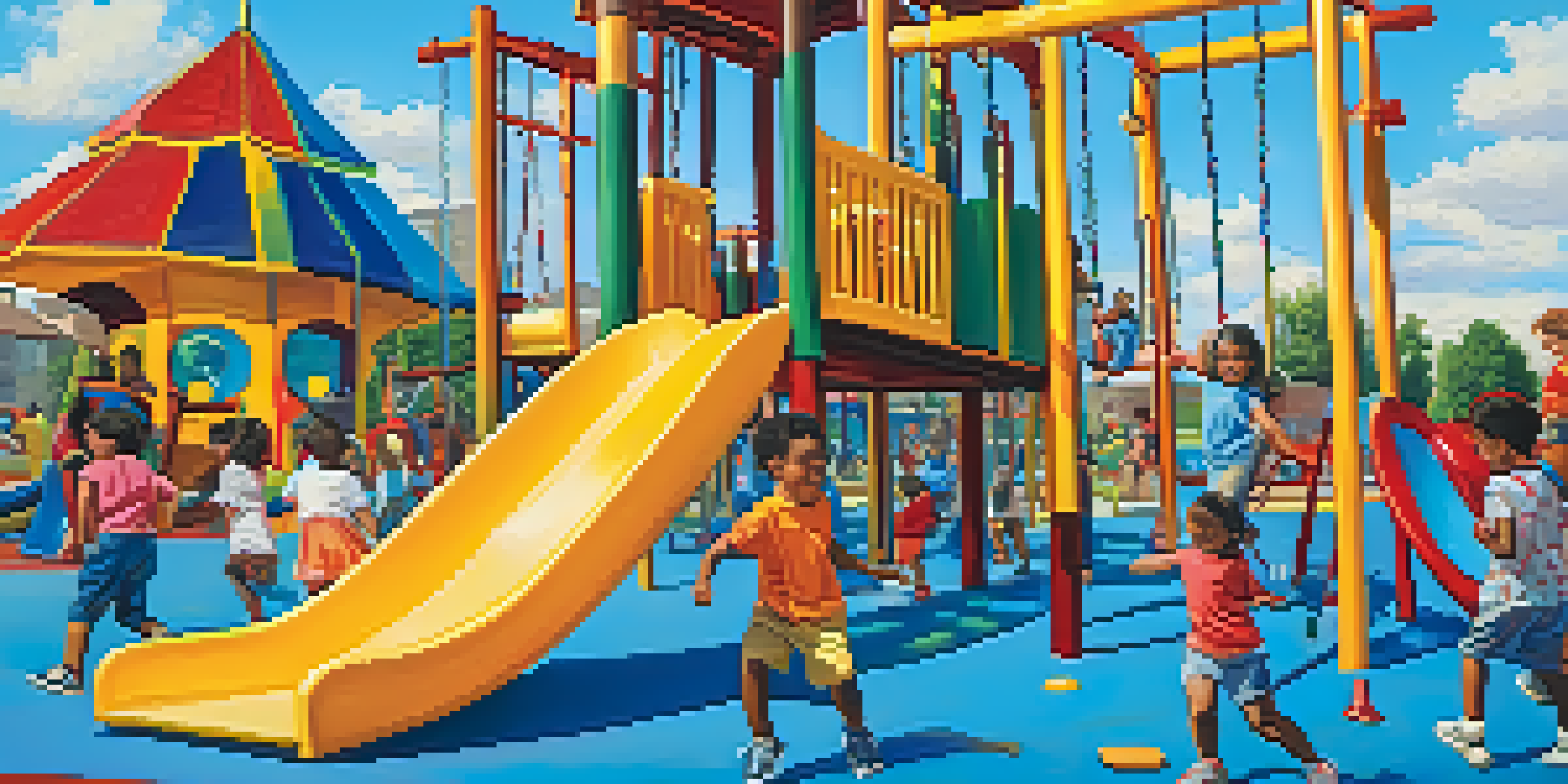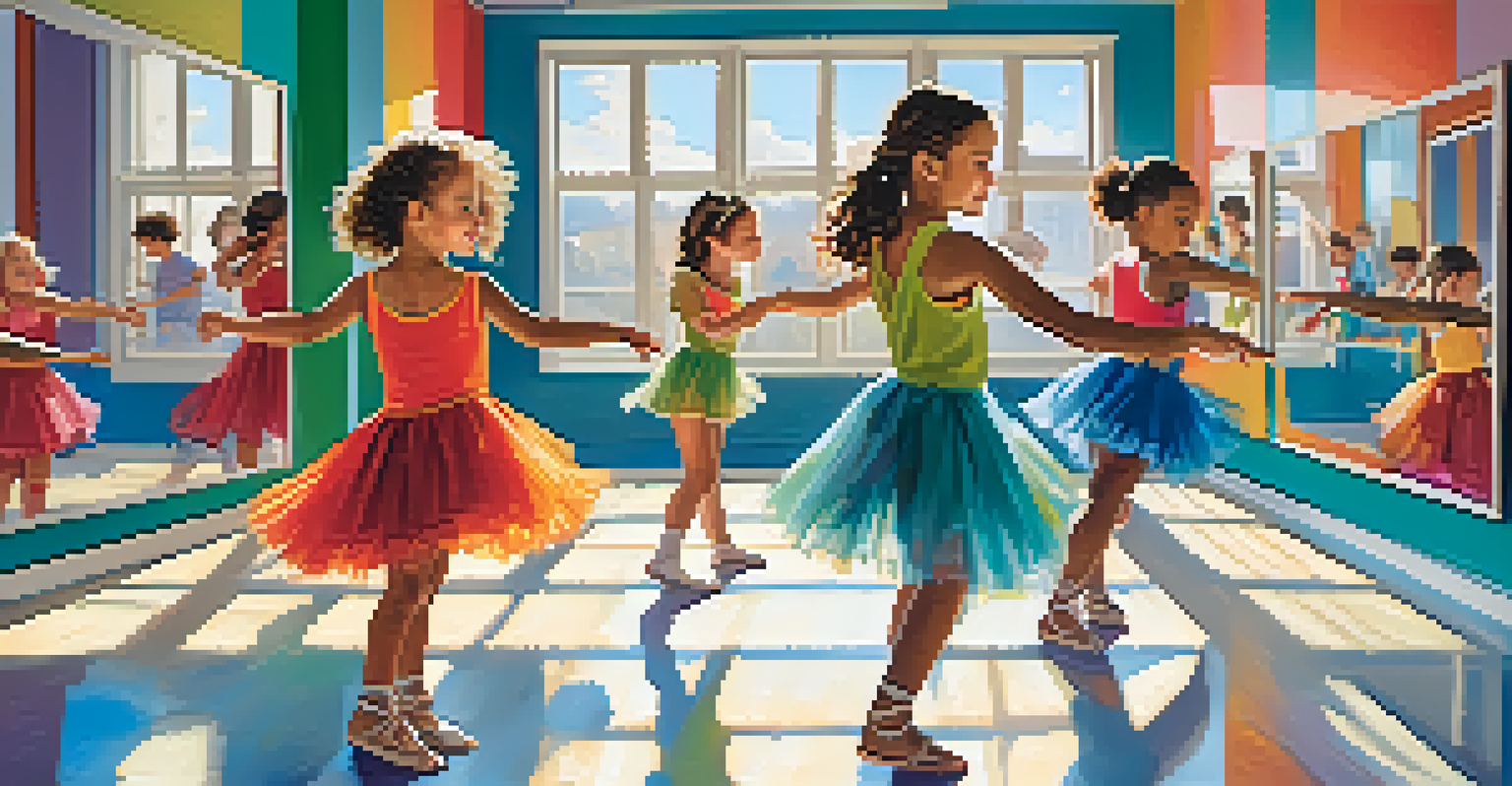The Impact of Music on Dance and Play in Child Development

Understanding Child Development Through Movement
Child development is a complex process that involves physical, social, emotional, and cognitive growth. Movement activities, like dance and play, are essential in this journey as they help children express themselves and learn new skills. Engaging in movement fosters coordination, balance, and rhythm, which are vital for overall development.
Dance is the hidden language of the soul.
When children dance or play, they not only enjoy themselves but also engage different areas of their brain. For instance, rhythmic movements can enhance motor skills and improve cognitive functions. This interplay between movement and brain development sets the stage for learning and creativity.
Moreover, the social aspect of dance and play cannot be overlooked. These activities often involve groups, encouraging children to cooperate, share, and communicate. This social interaction is crucial for developing empathy and understanding, which are foundational for healthy relationships.
The Power of Music in Enhancing Play
Music serves as a powerful tool that can elevate play to a whole new level. When children play with music in the background, they often become more engaged and energetic. The right tunes can inspire imaginative scenarios, turning a simple game into an epic adventure.

Moreover, music can help set the mood for different types of play. Upbeat rhythms might ignite a burst of energy for active games, while softer melodies can create a calming atmosphere for quieter, introspective activities. This versatility makes music an invaluable companion in children's playtime.
Movement Boosts Child Development
Engaging in movement activities like dance and play enhances children's physical, social, emotional, and cognitive growth.
In addition, incorporating music into play can enhance memory and learning. Children often remember songs better than spoken instructions. This natural tendency helps them grasp concepts more easily, making learning through play both enjoyable and effective.
Dance: A Creative Expression for Kids
Dance is not just movement; it's a form of creative expression that allows children to communicate feelings and ideas. Through dance, kids learn to interpret music and express themselves without words, which can be liberating and empowering. This form of expression can also boost their self-esteem and confidence.
Music can change the world because it can change people.
As children experiment with different dance styles, they explore cultural diversity and history. This exposure broadens their understanding of the world and fosters appreciation for various art forms. Through dance, they not only learn about rhythm but also about the stories and traditions that music carries.
Additionally, dance encourages improvisation and spontaneity. When kids create their own dance moves, they are practicing problem-solving and critical thinking. This playful experimentation can lead to innovative thinking in other areas of their lives.
The Impact of Rhythm on Motor Skills
Rhythm plays a crucial role in developing motor skills in children. When they dance to music with a strong beat, they learn to synchronize their movements, improving coordination and timing. This rhythmic movement is foundational for more complex motor skills that they will need as they grow.
Activities like clapping, stomping, or jumping in time with music help children become more aware of their bodies in space. This awareness is essential for activities like sports and even daily tasks. By fostering these skills through music and dance, we prepare them for a wide range of physical challenges.
Music Enhances Play and Learning
Incorporating music into play not only elevates engagement but also aids memory and learning through rhythmic patterns.
Moreover, rhythmic activities can also enhance focus and attention span. When children follow a beat or pattern, they learn to concentrate and remain engaged, which are vital skills for academic success. This connection between rhythm and attention is a great reason to incorporate more music into their routines.
Music and Emotional Development in Kids
Music has a profound impact on emotional development, helping children understand and express their feelings. When kids listen to or create music, they are often navigating a range of emotions, from joy to sadness. This emotional exploration is crucial for developing emotional intelligence.
Participating in dance and music activities can also serve as an outlet for stress and anxiety. Kids often find comfort in physical movement and musical expression, allowing them to release pent-up emotions in a healthy way. This coping mechanism is important for mental well-being.
Furthermore, music can enhance empathy among children. By experiencing different genres and cultures through music, they gain insight into the feelings and stories of others. This exposure cultivates compassion and a deeper understanding of the human experience.
Social Skills Developed Through Music and Dance
Engaging in music and dance activities naturally promotes social skills among children. When they dance in groups or play music together, they learn to communicate and collaborate with peers. These interactions are essential for building friendships and learning to work as a team.
Sharing musical instruments or taking turns in dance routines teaches children about cooperation and patience. They develop a sense of community and belonging, which is critical for their social development. Learning to navigate social dynamics in a playful setting prepares them for more complex relationships later on.
Dance Fosters Creativity and Confidence
Through dance, children express themselves, explore cultural diversity, and develop problem-solving skills in a fun, creative environment.
Moreover, participating in music and dance can help children develop leadership skills. When they lead a dance routine or organize a musical game, they practice decision-making and responsibility. These experiences foster confidence and assertiveness, traits that will benefit them throughout life.
Incorporating Music and Dance into Daily Activities
Integrating music and dance into daily routines can be simple and fun. Parents and caregivers can create designated 'dance breaks' during activities, allowing children to express themselves freely. These breaks not only provide physical activity but also inject joy into the day.
Moreover, using music during transitions can help children adapt to changes more smoothly. For instance, playing a song during cleanup time can make the task feel less daunting and more enjoyable. This approach can turn mundane chores into a fun experience.

Additionally, encouraging children to create their own music and dance routines can spark creativity. Providing them with instruments or props inspires them to explore and invent, making every day an opportunity for artistic expression. This involvement nurtures their creativity and keeps them actively engaged.